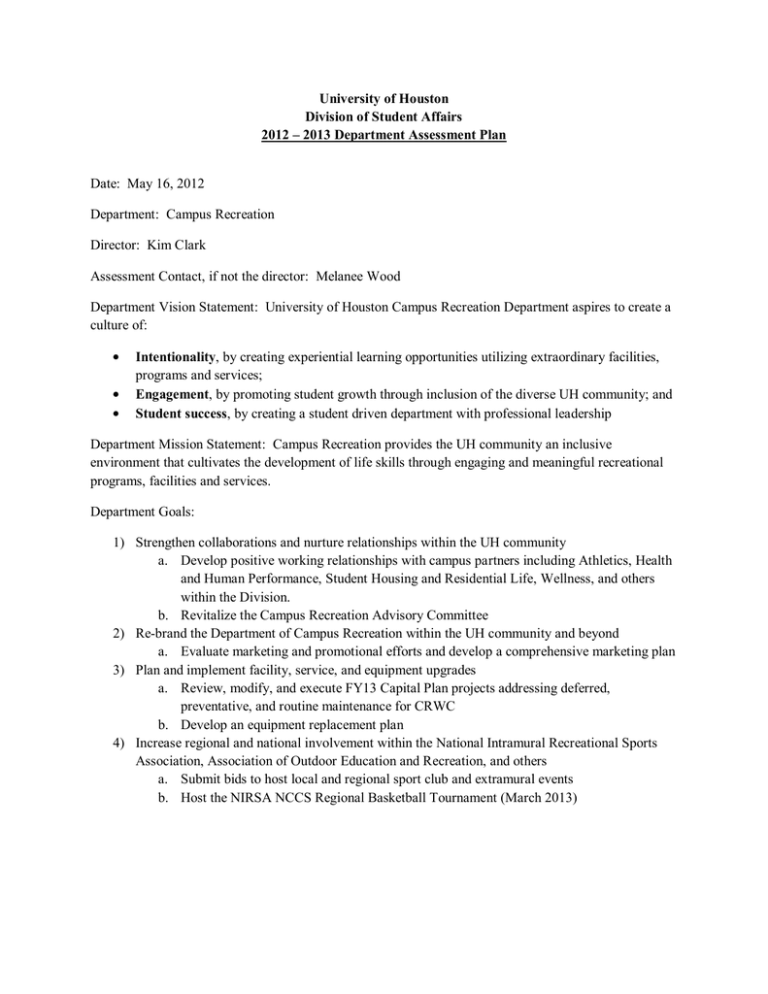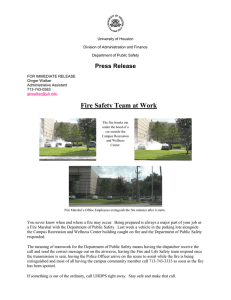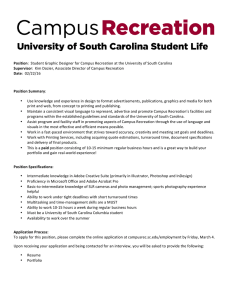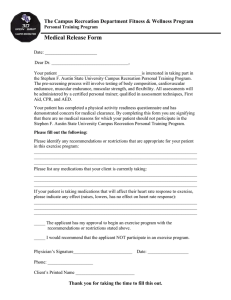University of Houston Division of Student Affairs
advertisement

University of Houston Division of Student Affairs 2012 – 2013 Department Assessment Plan Date: May 16, 2012 Department: Campus Recreation Director: Kim Clark Assessment Contact, if not the director: Melanee Wood Department Vision Statement: University of Houston Campus Recreation Department aspires to create a culture of: Intentionality, by creating experiential learning opportunities utilizing extraordinary facilities, programs and services; Engagement, by promoting student growth through inclusion of the diverse UH community; and Student success, by creating a student driven department with professional leadership Department Mission Statement: Campus Recreation provides the UH community an inclusive environment that cultivates the development of life skills through engaging and meaningful recreational programs, facilities and services. Department Goals: 1) Strengthen collaborations and nurture relationships within the UH community a. Develop positive working relationships with campus partners including Athletics, Health and Human Performance, Student Housing and Residential Life, Wellness, and others within the Division. b. Revitalize the Campus Recreation Advisory Committee 2) Re-brand the Department of Campus Recreation within the UH community and beyond a. Evaluate marketing and promotional efforts and develop a comprehensive marketing plan 3) Plan and implement facility, service, and equipment upgrades a. Review, modify, and execute FY13 Capital Plan projects addressing deferred, preventative, and routine maintenance for CRWC b. Develop an equipment replacement plan 4) Increase regional and national involvement within the National Intramural Recreational Sports Association, Association of Outdoor Education and Recreation, and others a. Submit bids to host local and regional sport club and extramural events b. Host the NIRSA NCCS Regional Basketball Tournament (March 2013) Department Name Campus Recreation Assessment Report for Academic Year 2012-2013 Program or Service Being Assessed: Student Employment - Performance Evaluations Learning Outcome(s) and /or Program Objective(s) Method Frequency Student employees will demonstrate Departmental performance rubric Minimum once per year - varies by essential performance characteristics results will be transcribed into Campus employment area and position. (attendance, punctuality, customer Labs for longitudinal tracking. service, communication, and initiative). Employees are exposed to performance expectations and job-related trainings during the All-Staff Orientation held in late August and monthly area-specific in-service meetings. Timeline Varies - Each of the 5 component area directors will determine the evaluation timeline for each of the positions they supervise. Purpose To verify that employees are meeting employment expectations, to provide feedback regarding relative strengths and areas for growth, and to provide a platform to launch a discussion about the employee's future goals and plans. Status Rubric being re-evaluated and updated. First evaluations planned for September. Program or Service Being Assessed: Student Employment - Emergency Response Procedures / Red Manikin Drills Learning Outcome(s) and /or Program Objective(s) Method Frequency Timeline Student employees will demonstrate Observation of drills recorded on a Each employee will be tested once per 12 months - due to the length of time proper techniques of CPR, First aid, and standardized rubric - staff will receive a year. If an employee fails the first RMD, that each RMD takes to conduct and the large number of students who need to AED according to American Red Cross pass or fail rating during the 'Red a second drill will be conducted. be assessed. standards and proper protocol and Manikin Drill.' Each RMD takes about decision making through the 30-45 minutes to conduct and the skills implementation of the Department of of each of the 250 Campus Recreation Campus Recreation Emergency Action employees will be assessed. Rubric Plan. Skills and knowledge for this scores will be transcribed into Campus outcome are gained during the Labs for longitudinal tracking and the employee's CPR/first aid certification development of an all-staff summary. course. All-Staff Orientation, and monthly in-service trainings. Purpose Status To ensure staff have the knowledge and Rubric in development. First skills to implement the Emergency RMDs planned for October. Action Plan and provide appropriate care for participants. Students who fail the first and second RMDs will be removed from the schedule until they are able to successful pass a drill. Program or Service Being Assessed: Student Employment - Exit Interview Survey Learning Outcome(s) and /or Program Objective(s) Method Student employees will learn On-line survey sent through Campus transferable professional skills including labs. leadership, decision making, problem solving, time management, and communication. Frequency Once per employee at the end of their employment with Campus Recreation. Timeline Rolling - survey will be sent out to individual employees at their time of departure throughout the year. Purpose Status To identify strengths and opportunities In development. for improvement related to staff training and overall student employment, as well as to show the impact of student employment within Campus Recreation including measures of overall student success. Department Name Campus Recreation Assessment Report for Academic Year 2012-2013 Program or Service Being Assessed: NASPA Consortium Campus Recreation Impact Study Learning Outcome(s) and /or Program Objective(s) To assess the level of participation in Campus Recreation services, the impact of Campus Recreation offerings on student recruitment and retention, and the recreation needs and interests of student and CRWC members. Method Frequency Online survey sent through Campus Once ever 3 years. Labs to a random sample of UH students and CRWC members. Sample size to be determined in conjunction with institutional research. Timeline Spring 2013 Purpose Status To gather benchmark data that can be Confirming necessity of IRB used to justify and inform decisions approval. related to recreation facilities, programs, and services; identify areas for program enhancement; and show the impact of Campus Recreation on student learning. Findings: Discussion: Program or Service Being Assessed: Learning Outcome(s) and /or Program Objective(s) Findings: Discussion: Method Frequency Timeline Purpose Status Provide a summary of assessment initiatives for this plan. For each program/service to be assessed, please provide the following: Name of Program Student EmploymentPerformance Evaluation Student Employment Emergency Response Procedures/Red Manikin Drills Student Employment – Exit Interview NASPA Consortium Campus Recreation Impact Study Goal/Purpose To verify that employees are meeting employment expectations, to provide feedback regarding relative strengths and areas for growth, and to discuss future goals and plans. To ensure staff have the knowledge and skills to implement the Emergency Action Plan and provide appropriate care for participants. To identify strengths and opportunities for improvement related to staff training and overall student employment, as well as to show the impact of student employment within Campus Recreation. To gather benchmark data that can be used to justify and inform decisions related to recreation facilities, programs, and services; identify areas for program enhancement; and show the impact of Campus Recreation on student learning. Learning/Program Outcome Student employees will demonstrate essential performance characteristics (attendance, punctuality, customer service, communication, and initiative). Student employees will demonstrate proper techniques of CPR, First Aid, and AED according to American Red Cross standards and proper protocol and decision making through the implementation of the Department of Campus Recreation Emergency Action Plan. Student employees will learn transferable professional skills including leadership, decision making, problem solving, time management, and communication. To assess the level of participation in campus recreation services, the impact of campus recreation offerings on student recruitment and retention, and the recreational needs and interests of students. Common definitions: 1. 2. 3. 4. Vision: The vision describes what the office will look like in the future. The vision of the department should support the overall vision of the Division of Student Affairs. Mission: The mission describes the purpose of the organization and the constituents it serves. The mission of the department will support the mission of the Division of Student Affairs. Goals: Program goals are overarching statements that describe what a program is trying to accomplish. Outcomes: a. Learning Outcome articulates the measurable expected results of an activity or program efforts. Outcomes are not knowing, thinking and understanding, but rather a demonstration of knowing, 5. 6. 7. thinking or understanding. Outcomes describe measureable behaviors achieved by participating in the activity. b. Program Outcome describes those operational and or business elements of a program or activity that can be counted such as research dollars, number of students served, their level of satisfaction, and number and or type of appointments by students. Assessment Methods: The assessment methods include the criteria, process, and tools used to determine if the intended outcomes were reached. Findings: Briefly describe the results of the assessment. Discussion: Outline the specific actions to be taken as a result of the information gathered. May 8, 2012



